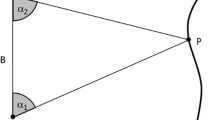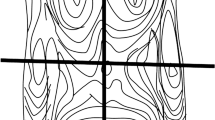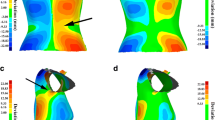Abstract
Purpose
Aim of this cross-sectional study was to evaluate the reproducibility of back surface measurements obtained by rasterstereography (RS) in adolescents with idiopathic scoliosis (AIS), and to identify the most informative RS parameters through a multi-step reduction analysis approach.
Methods
Sixty-six AIS were assessed with a RS scanner. The assessment was repeated in the same day 15 min after the first scan and after 1 week. Intraclass-correlation analyses were conducted to verify the consistency of the measurements. A multi-step reduction technique including correlation, principal component analysis (PCA) and regression was employed to extract a core-set of key RS parameters.
Results
Back surface measures were obtained from 66 AIS aged 10–17 years (median 13), with a mild Scoliosis angle < 25 (median 20). The reliability over the 3 sessions proved high to very high, with all the intraclass correlation coefficients ≥ 0.8 and 32 out of 48 coefficients ≥ 0.9. Only 8 of the 12 parameters provided by the RS device showed significant inter-item correlations and were therefore considered for further analyses. PCA extracted 4 of them, which entered the final regression analysis. High beta coefficients were found for 2 predictors: “Surface rotation-rms” and “Side deviation-rms,” which were found to be significantly associated with the dependent variable “Scoliosis angle.”
Conclusions
Data showed that RS measurements are reliable in AIS with mild severity of scoliosis. “Surface rotation” and “Side deviation” were the best descriptors of the Scoliosis angle and should be considered as key parameters when surveilling AIS with mild curves by RS surface topography.
Graphical abstract
These slides can be retrieved under Electronic Supplementary Material.



Similar content being viewed by others
References
Raso VJ, Lou E, Hill DL, Mahood JK, Moreau MJ, Durdle NG (2009) Trunk distortion in adolescent idiopathic scoliosis. J Pediatr Orthop 18:222–226
Knott P, Sturm P, Lonner B, Cahill P, Betsch M, McCarthy R, Kelly M, Lenke L, Betz R (2016) Multicenter comparison of 3D spinal measurements using surface topography with those from conventional radiography. Spine Deform 4:98–103
Doody MM, Lonstein JE, Stovall M, Hacker DG, Luckyanov N, Land CE (2000) Breast cancer mortality after diagnostic radiography: findings from the US Scoliosis Cohort Study. Spine 25:2052–2063
Don R, Capodaglio P, Cimolin V, Benedetti MG, D’Osualdo F, Frigo C, Vismara L, Negrini S (2012) Instrumental measures of spinal function: is it worth? A state-of-the art from a clinical perspective. Eur J Phys Rehabil Med 48:255–273
Drerup B, Hierholzer E (1994) Back shape measurement using video rasterstereography and three-dimensional reconstruction of spinal shape. Clin Biomech 9:28–36
Mohokum M, Mendoza S, Udo W, Sitter H, Paletta JR, Skwara A (2010) Reproducibility of rasterstereography for kyphotic and lordotic angles, trunk length, and trunk inclination: a reliability study. Spine 35:1353–1358
Guidetti L, Bonavolontà V, Tito A, Reis VM, Gallotta MC, Baldari C (2013) Intra- and interday reliability of spine rasterstereography. Biomed Res Int 2013:745480
Drerup B (2014) Rasterstereographic measurement of scoliotic deformity. Scoliosis 9:22
Gipsman A, Rauschert L, Daneshvar M, Knott P (2014) Evaluating the reproducibility of motion analysis scanning of the spine during walking. Adv Med 2014:721829
Schroeder J, Reer R, Braumann KM (2015) Video raster stereography back shape reconstruction: a reliability study for sagittal, frontal, and transversal plane parameters. Eur Spine J 24:262–269
Lyon R, Liu XC, Thometz JG, Nelson ER, Logan B (2004) Reproducibility of spinal back-contour measurements taken with raster stereography in adolescent idiopathic scoliosis. Am J Orthop (Belle Mead NJ) 33:67–70
Portney LG, Watkins MP (2001) Foundations of clinical research: applications to practice, 3rd edn. F.A. Davis Company, Philadelphia
Weir JP (2005) Quantifying test–retest reliability using the intraclass correlation coefficient and the sem. J Strength Cond Res 19:231–240
Ponseti IV, Friedman B (1950) Prognosis in idiopathic scoliosis. J Bone Joint Surg Am 32:381–395
Drerup B, Hierholzer E (1987) Automatic localization of anatomical landmarks on the back surface and construction of a body-fixed coordinate system. J Biomech 20:961–970
Cohen J (1988) Statistical power analysis for the behavioral sciences, 2nd edn. Lawrence Earlbaum Associates, Hillsdale
Shrout PE, Fleiss JL (1979) Intraclass correlations: uses in assessing rater reliability. Psychol Bull 86:420
Guyatt G, Walter S, Norman G (1987) Measuring change over time: assessing the usefulness of evaluative instruments. J Chronic Dis 40:171–178
Delis I, Berret B, Pozzo T, Panzeri S (2013) A methodology for assessing the effect of correlations among muscle synergy activations on task-discriminating information. Front Comput Neurosci 7:54
Johnson RA, Wichern DW (2007) Applied multivariate statistical analysis, 6th edn. Pearson, New York
Manly BFJ (2005) Multivariate statistical methods: a primer, 3rd edn. Chapman & Hall, London
Kaiser HF (1970) A second generation little jiffy. Psychometrika 35:401–416
Jolliffe IT (2009) Principal component analysis, 2nd edn. Springer, Berlin
Freedman D, Pisani R, Purves R (2009) Principal Component Analysis, 4th edn. WW Norton & Company, New York
Tanure MC, Pinheiro AP, Oliveira AS (2010) Reliability assessment of Cobb angle measurements using manual and digital methods. Spine J 30:769–774
Pino-Almero L, Mínguez-Rey MF, Sentamans-Segarra S, Salvador-Palmer MR, Anda RM, La OJL (2016) Quantification of topographic changes in the surface of back of young patients monitored for idiopathic scoliosis: correlation with radiographic variables. J Biomed Opt 21(11):116001
Betsch M, Wild M, Rath B, Tingart M, Schulze A, Quack V (2015) Radiation-free diagnosis of scoliosis: an overview of the surface and spine topography. Orthopade 44(11):845–851
Acknowledgements
The authors are indebted to Dr. Gianni Moi for his technical assistance in performing the rastereographic scans.
Author information
Authors and Affiliations
Corresponding author
Ethics declarations
Conflict of interest
The authors declare that they have no conflict of interest.
Electronic supplementary material
Below is the link to the electronic supplementary material.
Rights and permissions
About this article
Cite this article
Manca, A., Monticone, M., Cugusi, L. et al. Back surface measurements by rasterstereography for adolescent idiopathic scoliosis: from reproducibility to data reduction analyses. Eur Spine J 27, 2130–2138 (2018). https://doi.org/10.1007/s00586-018-5645-6
Received:
Accepted:
Published:
Issue Date:
DOI: https://doi.org/10.1007/s00586-018-5645-6




